Manipulations - Index
|
|
|
|---|
|
Manipulations - Index |
Preserving the integrity of honey bee nest structure
|
|---|
This page is largely as Dave Cushman left it. I have done a little tidying up, but not removed any meaningful text. Although Dave probably never used this system, much of it clearly shows me his extensive knowledge of honey bees and deep thinking. Yes, there is some conjecture here, but in general, I think it's all sound. I have often thought that when we move frames around in a colony, we are smashing up what bees have placed and where, so I have some sympathy with the suggestions. Very often, beekeepers, even some who think they know everything, don't consider what the bees are trying to achieve. R.P.
Preserving the integrity of fine structure of the nests of honey bees, when the nests are within managed honey bee hives.
The larvae raised in the smallest cells near the nest centre are sometimes left unsealed, often called bald brood (The most common cause of bald brood is the tunnelling of greater wax moth underneath brood cappings. The bees detect it and remove it, so leaving uncapped brood, often in straight lines. R.P.). This enables worker bees to purge many varroa mites that infest these cells, sometimes going to the extent of eating the larva's head off to get at and remove the varroa. Mites that are removed in this way tend to show severe mandibular cut marks and missing legs. (This is a different thing. Bald brood leaves the pupae intact, where they will usually emerge as live adults. R.P.). The protein from the chewing of larvae is re-cycled into fresh brood food. This activity seems only to occur in the smallest cells at the nest centre and there is a seasonal timing to it that relates to spring and late summer, but the correlation is more to do with the population dynamics of varroa than of the bees themselves.
If a colony has combs that have arrived in the box in a random fashion it is unlikely that this fine structure of graded cell sizes is present and so such mite destruction does not occur and the varroa mites that might have succumbed to the activity are available to multiply.
It may be that we need to re-assess the way we house colonies, so that the fine structure that happens in hollow trees and other cavities can be preserved, in order to make use of this self cleansing. There seems to be a lot of anecdotal evidence of longer term survival of such colonies, with less or even zero treatment for mites. There is also a body of similar evidence from top bar hives, which tend to have a less disturbed arrangement of combs, as the bars are often left in the order that they first started in.
What I am about to suggest is not proven in UK, but neither can I see any adverse possibilities arising from it's use.
There are some very simple things that we can do for ourselves to establish this fine structure in our own hives and perhaps reduce our reliance on varroa treatments. When taken along with other Integrated Pest Management (IPM) techniques, it is likely to help rather than hinder. We are always being encouraged to renew our comb more frequently, to eliminate build up of disease spores and chemical residues, but we tend to do this on a comb by comb basis, working each comb gradually outwards until it is finally removed, which disrupts any fine structure that may have existed. So instead, let us think of renewing a whole box at a time. This is not a new idea, but it has not been fashionable for many years.
Our complete comb renewal is going to start with a brood break, which will help to reduce the opportunity for varroa to breed. By leaving all old comb behind in one operation, we are getting away from any disease spores or chemical treatment residues that might be in it, which is not a bad thing in itself. We can either sacrifice the brood, or use the frames to bolster other colonies, as long as we realise their age and likely varroa load.
In most cases, I think we may make our new colonies out of existing ones by taking a Taranov swarm or a shook swarm, such swarm like groups of bees usually get away to a vigorous start. It is also possible to apply this process to an entire colony that has been shaken from it's combs.
Our nest rebuilding in our freshly sterilised hive has to be done in a fashion so that the central core is produced first and with a low influence from foundation. (This is so the bees can build the comb how they want it. My guess is there will be little, if any, drone comb built on these central frames. I think drone comb will be drawn on the periphery of the nest, as happens in a wild nest. It is usual for bees to build comb with smaller cells than those from which they were raised, hence the lack of influence from foundation. R.P.).
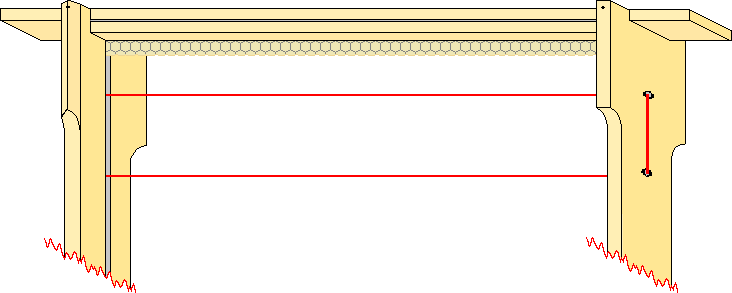
I reckon three frames like this, makes sense for this purpose, with the frames fitted with very skimpy starter strips to enable our bees to draw their comb with the least influence from the foundation itself and draw the frames very quickly. (I believe that 3 frames of starter strip like this is a mistake. I find that the bees rarely follow the starter, they build crossways. Best combs are built when one starter is placed between two flat combs. R.P.).
Rather than do this in a nuc box I reckon that the three frames should be put in the centre of a freshly sterilised brood box and the spaces either side filled with division boards, dummy frames or the large dummies sometimes used in queen rearing, with perhaps a frame feeder (or two) with syrup if there is not an intense nectar flow. The cross section below shows three frames with skimpy starters and a dummy flanking each side.
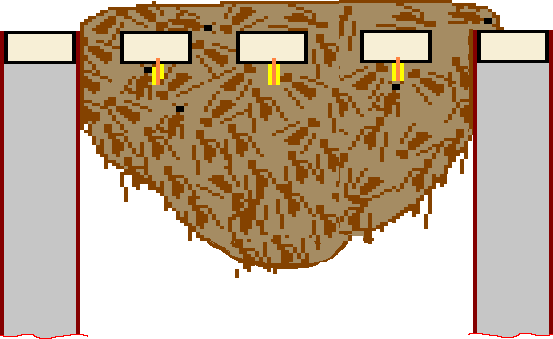
If this work can be done in a back garden, you can add a frame of foundation to either side of the growing nest every day or so as needed. The drawing below shows the layout at the start of the nest regeneration. (I'm not sure that adding foundation is a good idea, as it defeats the object. The bees will probably follow the impressions in the foundation, instead of building what they want and there will probably be less drone cells than if starter strips were used. Foundation is likely to have chemical residues, which is one of the reasons for performing the operation in the first place. R.P.)
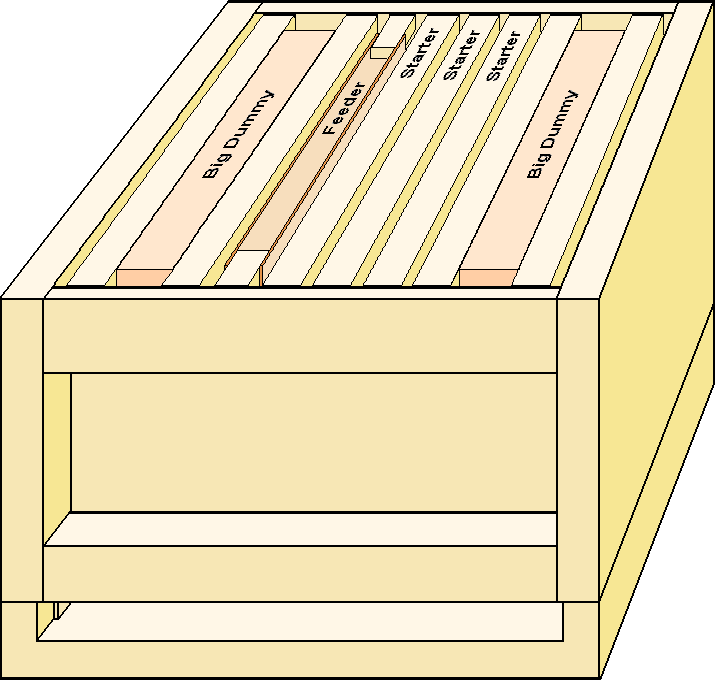
If frames are added one at a time at only one frame per side using dummy frames, the combs will be well drawn, drawn quickly and will be very flat. The drawing below shows the layout after two frames of foundation have been added.
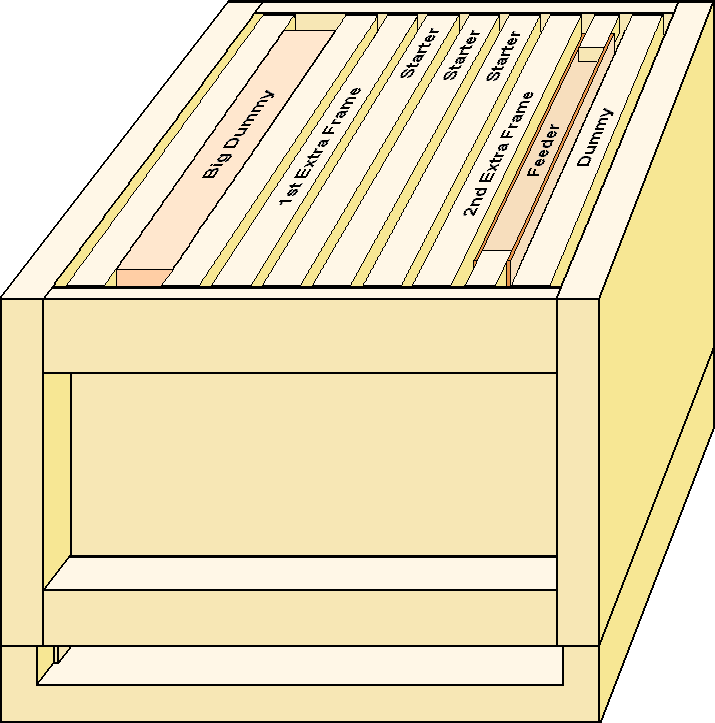
|
Keep up the additions until the whole box is filled with frames, then we can add the final touch. By drawing a heavy line with a felt tipped pen diagonally across all the frames in the box we have a reference that is linked to the fine structure mentioned earlier, such a line will help you to make decisions about any changes you may want to make to the order of frames or adding and removal of frames. The diagonal line also takes notice of any symmetry of the nest about the central core (Housel positioning) and frames from other similarly marked sets also become interchangeable providing their stripe matches the overall line. (This is wishful thinking. I see what Dave Cushman was trying to achieve, but I think it's unworkable in a normal apiary, where frames get moved for several reasons, such as a test comb and moving frames of food and brood. R.P.). |
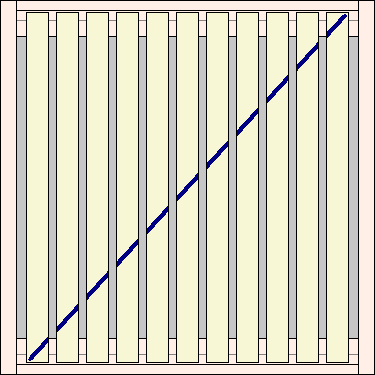
|
|---|
There are likely to be flaws in this idea somewhere, but I can't see any yet. (I'm afraid I have seen what I think are flaws, that I have commented above. I don't see there is anything that can't be overcome. R.P.). Such a process repeated every four years, or more often, is going to go a long way to reducing treatment need, simply by the comb always being reasonably fresh and clean. If we are more diligent about monitoring the actual varroa load a hive carries, then we can make better informed choices about what treatment to use and how often. The treatment must match the problem. There is no point in treating a hive that has little or no varroa.
I have not yet evaluated what this fine structure means as far as drone health and virility goes, as they are usually generated in small patches on the outer edges of the main nest, my first thoughts are that there will be no benefits or detriments to the drones, but I can see the need for some tedious measuring of drone cell patches to see if any fine structure exists there. If drone brood is being sacrificed as part of your IPM regime, then I think that this should be limited to frames in either of the outer two positions either side. So that any drones raised on more central frames in small patches are the ones that are available for mating.
Colonies raised in this way from swarm like quantities of bees, get off to a strong start and build up rapidly, you may be surprised by the strength, health and vigour that they exhibit. The build up can be so fast that at the end of the season you can't tell the difference in strength between the new colony and what the old colony would have been, if the new nest structure had not been produced.
If you have been troubled by virus infections vectored by varroa, you can use this technique season after season to reduce the incidence of infective organisms, however you will lose out a bit on honey crop by so doing. If that is the price of survival, the pill has to be swallowed.
| Prof. Stan Schneider | University of North Carolina | |
| Eva Crane | Ex director of IBRA. | |
| Derek Steed | Paint scientist and Buckfast bee enthusiast | |
| Tom Rinderer | Geneticist US dept. of Agriculture | |
| Beowulf Cooper | Entomologist and founder of BIBBA (deceased). | |
| Giancarlo A. Piccirillo | University Zulia Venezuela. | |
| David De Jong | University of Sao Paulo, Brazil | |
| Lionel S. Gonçalves | University of Hohenheim. | |
| Eric H. Erickson | Carl Hayden Bee Research Center, Tucson, Arizona. | |
| Dennis Murrell | Wyoming | |
| Ian Rumsey |
In addition to those specifically mentioned, I would like to thank about one thousand other beekeepers and researchers that regularly contribute to and stimulate discussion on the various Email Discussion lists.
The following URLs may prove helpful in following up the items on this page
Cell Size Testing
Chris Slade's Comb
Foundation and Comb
Cellsize Regression
Cell Sizes
Numerous other Internet sites... As this is where all the recent information is published
Special thanks are due to Delores Lusby for stimulating the initial research and Marla Spivak for encouraging me to follow up some of the original absurd suggestions, but my biggest thanks go to Dennis Murrell for picking up the ball when I was about to throw the towel in.
There will be those that rigidly think in straight lines and only believe what has been scientifically proven, who will dismiss what Dave Cushman proposed above. That is to be expected, but if you don't do anything differently, you will never improve. I like experiments like this, because it is an attempt to work in unison with bees and, for a dedicated person who has the discipline to carry it out, thire is a brillant citizen science project here. The key is to have an open mind, but at the same time have belief that it will work. R.P.).
Originally written by Dave Cushman. Edited and additions by Roger Patterson.
Page created 26/01/2006
Page updated 27/12/2022
Written... 26 January 2006, Revised... 15 May 2006,
|